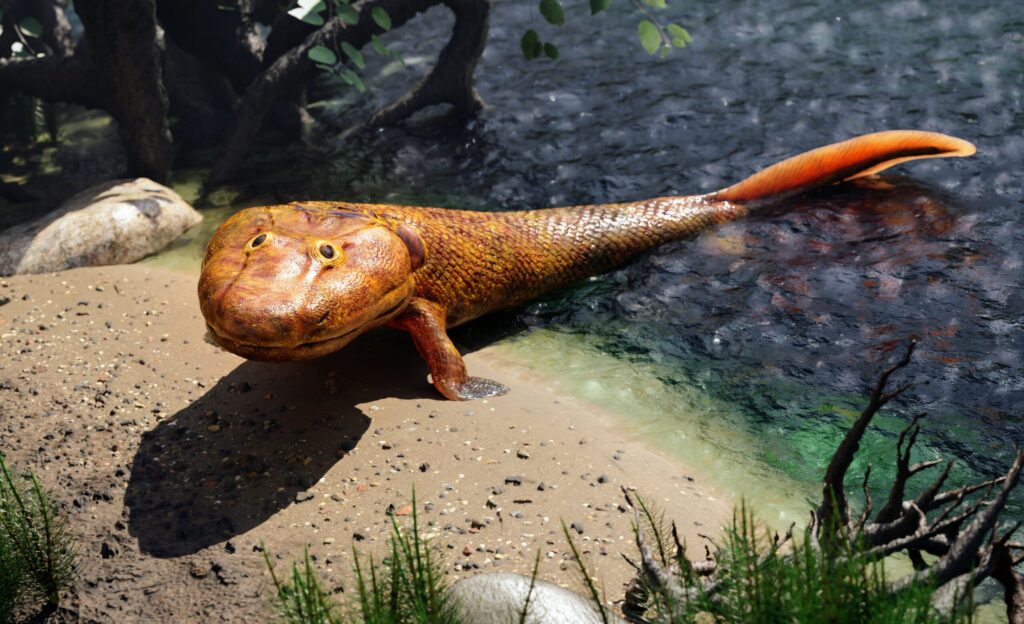
Do fish have legs?
Fish with legs? What did you just read? Is this even possible? This may be hypothetical, but it is not. Although we’ve grown up reading that fish are species that move with tails and fins, we’ve all wondered if there are legged fish and what they look like. Although there are many fish with no legs however there are a surprising number of fish that are equipped with legs, usually fins that have evolved to act as legs.
Do fish really have legs?
It is impossible to imagine a fish with legs because it prevents them from swimming. However, many scientists have suggested that amphipods(walking vertebrates), which are land-dwelling species, evolved from fish thousands of years ago. The theory suggests that fish fins evolved into the legs that we all use to get around. Evolution has given these creatures the ability to walk on water or land.
These are fish fins that have evolved into leg-like limbs and they usually move along the sea floor using their leg-like fins and tails. Walking fish are usually buoyant. Because these fish can spend long periods out of the water, they can use a variety of locomotion strategies, such as leaping, snake-like lateral twisting, and tripod-like walking.
Some fish have legs to walk. Some fish have legs that they can use to move around on land. They differ from other fish in many ways. A strange species of leggy fish has been discovered in New Zealand
Fish with legs evolution:
Several hundred million years ago, fish began to develop limbs that enabled them to walk underwater. From these fishes to modern mammals, including humans. With the discovery of the world’s oldest known arm bone, scientists have concluded that many of the physical features we associate with life on Earth, including the bone structure and muscles necessary for walking and doing push-ups, Their evolutionary roots are in fish.
Scientists investigating 375-million-year-old fish fossils discovered in Ellesmere Island, northern Canada in 2004, found that their hind legs were long before they moved to land. The significance of the tick became apparent when scientists put it on an evolutionary tree, along with land vertebrates – called tetrapods – and other tetrapod-like fish. By looking at these branches, scientists could see how the tetrapod’s body evolved step by step. Fish first developed long bones in their legs, later adding wrists and ankles. Later still the fingers and toes rose.
The researchers say that the closest relatives of limbed animal ancestors, such as humans, developed the basis of hind legs before moving to land. He added that this ancestor may have been able to walk underwater. These findings suggest that a major step in the evolution of hind limbs occurred in fish, challenging previous theories that such appendages evolved only after they moved to land.
Fish with legs Florida:
A fish-like creature with “legs” in a central Florida lake sparked controversy over the weekend. Shauna Mitchell said she was fishing on Stark Lake in Ocoee when she pulled something strange out of the water. Mitchell’s photos show what appears to be a fish that have legs and no scales. She said she “freaked out a bit” after pulling the creature onto the pier. Locals have suggested that the strange creature was a mud dog, eel, lungfish or Chinese walking fish. However, an official described the “fish” as a large siren. It is an amphibian that is a member of the salamander family. It is described as being very isolated.

The walking catfish (Clarias batrachus) is a species of freshwater fish aboriginal to Southeast Asia. In Florida, they grow to about 20 inches long and 2.5 pounds, and their distinctly extended bodies have long dorsal (back) and anal (bottom) fins that run much of their length. These fish like to move from one body of water to another in search of food or a better place to live and they do this by moving on land. They use their pectoral fins to stay upright and slither along the ground in a snake-like motion. This non-native species was presented to Florida by humans in the 1960s
Fish with legs Australia:
Michelle Garside was fishing on Queensland’s Sunshine Coast on Sunday when she caught a black species that had legs in addition to fins. About 30 cm in size, with features like dark black scales, three wings and three legs.
A rare “walking” handfish unique to Australia has been spotted off the coast of Tasmania for the first time in 22 years. The pink handfish was last seen by a Tasmanian diver in 1999 and has only been seen four times.
The red handfish is one of several species of handfish that inhabit the coastal waters of southeastern Australia. It has quite unusual feathers. The front pair of fins look a bit like hands, while the pectoral fins extend away from the body like arms, ending in hand-like paddles on which they swim along the sea floor. The fish push against the seabed with these fins to move forward in search of food. It can swim quickly when needed, but it prefers to stay on the bottom of the ocean most of the time.
The movement of fish can be described as ‘walking’, but it is not the same as the walking of land animals. The red handfish was first described in 1849 and found in the vicinity of the convict settlement of Port Arthur. It is small, usually, about 8 cm (3.2 in) long when fully grown. They live at depths of 2–30 m (6–100 ft). They were once quite common in the area, but are now rare.
How do fins of fish change into feet?
Research on fossilized fish from the late Devonian period, roughly 375 million years ago, details the evolution of fins as they began to transition into limbs fit for walking on land. 375 million years ago, a rough, slimy aquatic creature evolved from a four-legged land animal, a clear example of a “backward” step in evolution. An evolutionary line of four-legged animals called tetrapods. But Neil Shubin of the University of Chicago says that the smooth limb bones of the newly described Cicactania wiki fossil could not have supported the muscles needed to stand up, i.e., “fishpods,” re-swimming, full-time aquatics had taken shape.
The scientists used this technique in sharks, swimming bony fish and land-walking fish, to see how muscle development varies between different species. These species represent different stages of the transition from sea to land, giving scientists a good idea of how fish muscles change as they prepare to walk on land.
Fish with legs fossil:

Tiktaalik roseae, are fish-like creatures that fill an important gap between fish and four-legged, land-dwelling animals. Now, the 375-million-year-old fossil’s back is having its close-up moment, and they’re showing a pelvis that marks it along the evolutionary path from fin to limb.
Scientists say that about 375 million years ago that fish crawled out of the sea with the physical characteristics to survive on land.
Scientists first discovered Tikataluk in 2004 while hunting for fossils on Ellesmere Island in the Canadian Arctic. Its unusual combination of gills, scales, fins, and lungs, combined with a movable neck, robust rib cage, and crocodile-like head, places the tick halfway between fish and the oldest four-legged land animals.
Fish with legs symbol:
Darwin’s fish, a symbol, is represented as a fish with legs, indicating support for the scientific theory of evolution as the cause of species diversity rather than creationism. Darwin redesigns the fish as a missing link in Christian symbolism, mocking the Christian faith by outfitting it with legs and feet. “In many ways, the Darwin fish display is like holding and violating an enemy flag, an act of ritual aggression,” says Dr Thomas M. Less, an associate professor in the Department of Speech Communication at the University of Georgia. ‘
The Darwin fish is an ichthys symbol with “evolved” legs and feet attached and contains the word Darwin (like ΙΧΘΥΣ or Jesus found in some Christian versions). It is intended to symbolize the theory of evolution as formulated by Charles Darwin as opposed to the pseudo-scientific “theory” of creationism, often associated with certain sects and sects of Christianity. It symbolizes both fish evolving into terrestrial vertebrates (for example, Tiktalaek) and the theoretical belief that gave way to evolutionary understanding.
List of all fish walking on land with legs:
Fish with feet can walk on land and breathe air for short periods, propelling themselves purposefully on land. Fish that can walk on land and breathe air are also capable of climbing. Here are 10 species of fish with arms and legs.
- Mudskipper:
When you think of land-dwelling fish, these are the fish you most often think of. Mudskippers have fins that point towards the front of their bodies and are placed low, allowing them to gain traction when walking on land. Mudskippers use their pelvic fins to aid in climbing and are capable of 2-foot leaps. Mudskippers are amphibious fish with legs on land that have adapted to spend most of their time on land.
2. Snakeheads:
These fish have long bodies, with snake-like heads. These fish “walk” by undulating across the land rather than using fins. Their respiratory system gives them the ability to survive on land for several days. They propel themselves by moving their head and hind fins in opposite directions. On land, it can take a large gulp of air through its mouth and continue breathing, thanks to a special chamber along its gills. This enables it to survive on Earth for four days! They are prepared to walk the earth. Unlike other walking fish, snakehead fish do not use their fins to walk on land.
3. Epaulette Shark:
These fish have long bodies, with snake-like heads. These fish “walk” by undulating across the land rather than using fins. Their respiratory system gives them the ability to survive on land for several days. They propel themselves by moving their head and hind fins in opposite directions. On land, it can take a large gulp of air through its mouth and continue breathing, thanks to a special chamber along its gills. This enables it to survive on Earth for four days! They are prepared to walk the earth. Unlike other walking fish, snakehead fish do not use their fins to walk on land.

4. Climbing Gourami:
These are grey, ray-finned fishes that have an organ, called the labyrinth organ, that allows them to breathe on land. They support themselves on their gill plates and use their tails to propel themselves on the ground.
5. Walking Catfish:
This freshwater catfish has an elongated body with sensory barbels that, like all catfish, are about 12-20 inches long. If they are looking for a new habitat, they can stay out of water for up to 30 hours
6. Mangrove Rivulus:
These are small fishes ranging from 2.5 to 6 cm in length. They are slender, with a body that is flattened posteriorly. Mangrove turtles are capable of spending an incredible 66 days out of water. They spend most of their time on the ground in fallen trees.
7. Bichir:
There are 11 recognized species of Bichirs. They are long fish, with varying numbers of beakers have a pair of lungs and can stay out of water for hours at a time provided their skin remains moist.

9. Garnai:
Gurnai is another type of fish that can walk on land. They usually live in the oceans. One thing that separates guerilla fish from other walking fish is that they can fly.
10. Shortnose Batfish:
These fish move slowly while hunting prey. Although they can walk, shortnose baitfish often do not. These fish also come in the category of fish with legs
10. Cave Angel Fish:
Cave Angel Fish is yet another fish with legs capable of stepping on land. These fish were first observed walking on rocks in Thailand. Walking helps them to grip the rocky streambeds while moving between habitats
FAQ:
How many legs does a fish have?
Tetra pods, or animals with four limbs, evolved from fish that migrated from water to land. Therefore fish have no organs. You can think of the tail fins as the legs of a fish. But if you look at a fish, its “legs” are just a small part of the tail.
Which is the First fish to walk on land?
The oldest fish capable of walking on land is Tiktaalik roseae, a type of sarcopterygian that lived in the late Devonian period, about 375 million years ago, in what is now the Canadian Arctic. Tiktaalik roseae, discovered in 2004 on Ellesmere Island in Nunavut, Canada, is an important transitional fossil that connects the first four-limbed vertebrate fish and tetrapods at the end of the Devonian period.
What fish has legs?
There is a surprising number of fish with legs. Whether they use their legs to walk on the ocean or lake floor or they come out of the water, these fish are endlessly fascinating.
- Frog Fish
- Lungfish
- Hand Fish
- Bat Fish
- Axoloti
- Mudskipper
Are there any fish with legs?
It is impossible to imagine a fish with limbs because it prevents them from swimming. However, there is evidence of 13 fish with legs species found that show the act of walking with legs. Something like an aquarium fish with legs and arms or fish with legs and tail.





